What sparks the creative spirit in Filipino art? How does it enrich the country’s cultural heritage? The Philippines boasts a lively art scene, mixing old and new. This blend highlights the nation’s skill and creativity.
The SM Art Market series is a key example. It lets Micro-, Small, and Medium Enterprises (MSMEs) share their art. This shows the country’s dedication to its creative sector. With artistic expression on full display, Filipino creativity is undeniable.
Filipino creativity goes beyond just art. It’s about innovation and talent too. The Regional Fiesta Haraya Initiative is a step towards making the Philippines a creative hub in Asia. It aims to grow the artistic community and boost local economy.
This year’s event theme, ‘Our Stories through Our Creations: We Are A Creative Nation,’ emphasizes storytelling in Filipino culture. It showcases the nation’s unique artistic talents.
Key Takeaways
- Filipino creativity is a blend of traditional and modern elements
- The SM Art Market series provides a platform for MSMEs to showcase their art
- The Regional Fiesta Haraya Initiative aims to position the Philippines as a premier creative hub in Asia
- Filipino art is driven by innovation and talent
- The country’s artistic expression is a significant part of its cultural heritage
- Initiatives like the SM Art Market and Regional Fiesta Haraya support local economic growth and foster the artistic community
The Essence of Filipino Creativity
Filipino creativity comes from the country’s rich culture and history. The mix of indigenous and foreign influences has shaped the nation’s design and art. You can see this in the patterns on traditional textiles and the modern buildings of Manila.
The community supports local artists and keeps traditional crafts alive. For example, the Kalinga Pottery has been popular for centuries. The community uses local clay to make high-quality ceramics. This shows the Filipino spirit of innovation and design.
- Rich cultural heritage and history
- Unique blend of indigenous and foreign influences
- Strong sense of community and tradition
- Innovative use of local materials and resources
Defining Creativity in the Filipino Context
Filipino creativity is more than just art. It’s about the community coming together to create something beautiful. The idea of “bayanihan” or communal spirit shows this, where people work together for a common goal.
Historical Influences on Filipino Creativity
The country’s history has shaped Filipino creativity. From the Spanish colonial period to today, different influences have made the nation’s culture and design unique. Knowing these historical influences helps us understand the essence of Filipino creativity and innovation.
Traditional Filipino Art Forms
Traditional Filipino art forms are key to the country’s culture and talent. The Philippine National Commission for Culture and the Arts divides Filipino arts into two main types: traditional and non-traditional art. Traditional arts include weaving, pottery, and folk performing arts.
Some notable traditional Filipino art forms include:
- Weaving and textiles, such as banig weaving and inabel textile weaving
- Pottery, which has been a part of Filipino culture for centuries
- Folk performing arts, including music, dance, and theater
The National Living Treasures Award is given to traditional artists or groups. It honors their role in preserving the country’s cultural heritage. This award shows the value of keeping traditional art alive and promoting Filipino culture and talent.
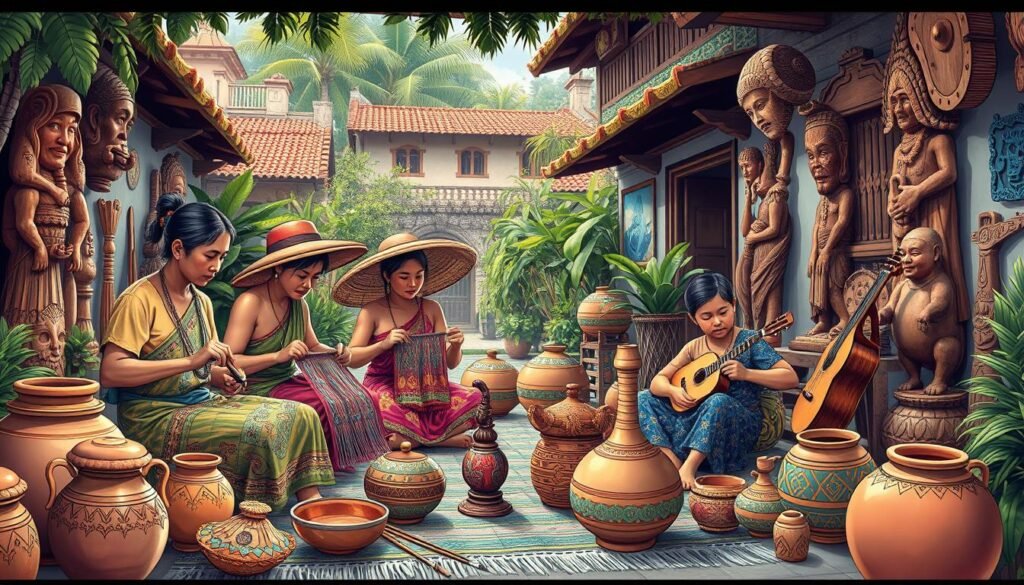
Traditional Filipino art forms are a source of national pride. They connect us to the country’s rich history and culture. By keeping these art forms alive, we ensure future generations can enjoy and appreciate Filipino art and talent.
| Art Form | Description |
|---|---|
| Weaving and Textiles | Traditional Filipino weaving techniques, including banig weaving and inabel textile weaving |
| Pottery | Traditional Filipino pottery, which has been a part of Filipino culture for centuries |
| Folk Performing Arts | Traditional Filipino music, dance, and theater |
Modern Interpretations of Filipino Arts
The Filipino art scene has changed a lot, thanks to new ideas and designs. Today, art is a way for artists to share their views and talents. The 1960s and 1970s were key times for modern art in the Philippines. Artists like Victorio Edades, Carlos “Botong” Francisco, and Galo Ocampo led the move towards modernity.
The Cultural Center of the Philippines (CCP) has been important in showing off different art styles. It has programs like “Art of the Regions” to highlight local artists. With more independent art spaces and groups, the art scene has grown. Filipino artists are now mixing old and new techniques to create exciting art.
Contemporary Visual Arts
Today’s visual arts in the Philippines are very different, with artists trying new things. Digital tech is big now, making art more interactive. This change has helped Filipino artists show their work worldwide, getting praise for their creativity.
Evolution of Filipino Music and Dance
Filipino music and dance have also changed a lot. Now, they mix old and new styles, creating something fresh and lively. This mix shows the talent and creativity of Filipino artists. From classical to modern dance, the performing arts in the Philippines have grown, thanks to its rich culture and ability to innovate.
The Role of Literature in Filipino Creativity
Filipino literature is a key part of the country’s art and culture. It shows the unique views and experiences of Filipinos. It mixes influences from different times, like before the Spanish came, during their rule, and today.
Supporting local authors is very important in Filipino literature. Many writers have helped make the country’s innovation in literature grow. Carlos Bulosan wrote about Filipino migration, and Francisco Balagtas added to the romantic poetry tradition.
Common themes in Filipino literature include family, community, resilience, and finding one’s identity. These themes are seen in different types of writing, like the tanaga and the pasyon.
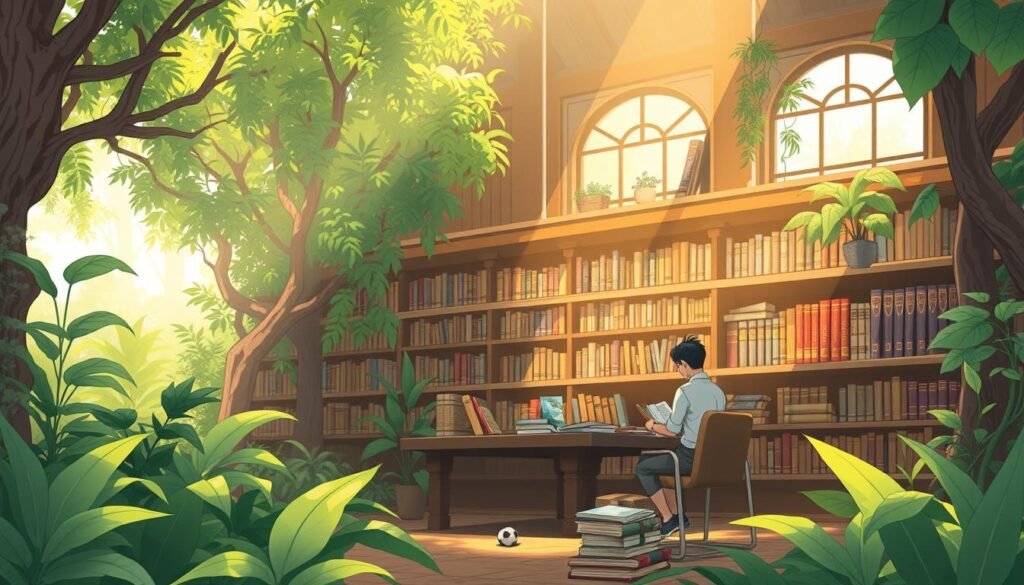
Filipino literature has changed a lot over time. Modern Filipino literature shows today’s experiences and boosts national pride. It combines indigenous, Spanish, and American influences, making a rich cultural mix in today’s literature.
| Literary Form | Description |
|---|---|
| Tanaga | A heptasyllabic quatrain form containing emotional content |
| Pasyon | A form of religious poetry that exists in multiple local languages |
| Metrical Romance | A literary genre that flourished during the 19th century, with notable works like “Florante at Laura” |
Filipino Film Industry: A Creative Landscape
The Filipino film industry is full of life and creativity. It shows off the country’s rich culture and talent. Over a century old, it has grown with new tech, stories, and views. It mixes old and new, showing the country’s many cultures.
Recently, creative industries added 7.3% to the Philippines’ GDP, worth Php 1.6 trillion in 2022. This growth comes from more people wanting quality content. Streaming and social media have helped. Filipino filmmakers are now seen in international festivals, showing their talent.
Indie Films: New Voices and Visions
Independent films are big in the Filipino scene. They bring new stories and views. These films are known for their design and fresh looks, winning awards worldwide. Indie films also help new talent get noticed.
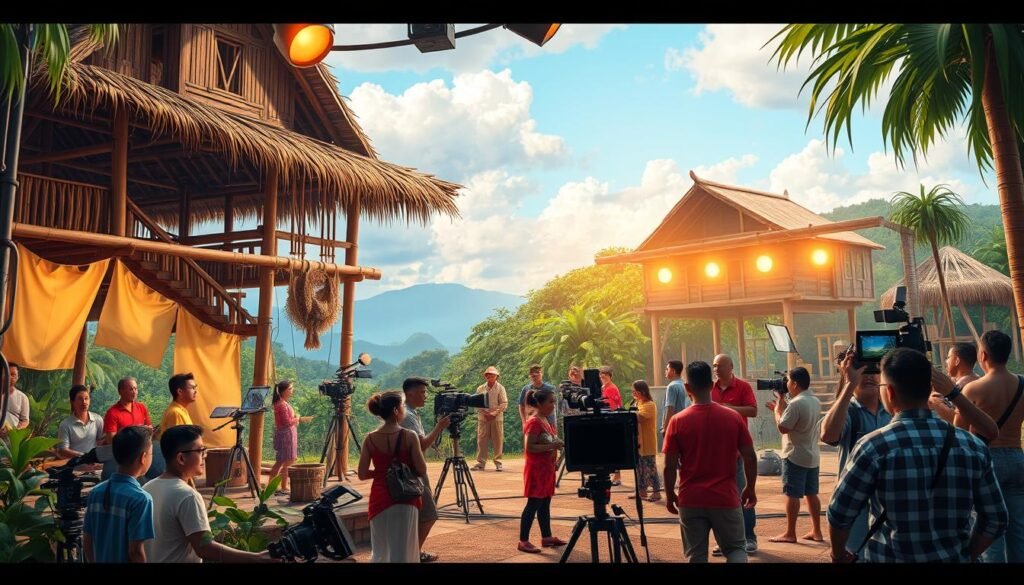
Influence of Filipino Cinema on Global Stage
Filipino movies are known worldwide. They show off the country’s culture and innovation. More global platforms are playing Filipino content. The government supports this growth, helping Filipino design and talent reach more people.
| Year | GDP Contribution | Employment Growth |
|---|---|---|
| 2022 | 7.3% | 10.5% |
| 2021 | 6.5% | 8.2% |
The Filipino film industry is a shining example of the country’s culture and innovation. It blends old and new, showing off Filipino design and talent to the world.
Celebrating Creativity in Festivals
Filipino festivals are a vibrant display of the country’s rich culture and art. These events showcase the unique heritage of the Philippines. They highlight the innovation and creativity of its people. From the colorful costumes to the detailed designs, every aspect of these festivals is a testament to the country’s artistic expression.
Some notable festivals in the Philippines include Sinulog and Pahiyas. Sinulog is a celebration of the Santo Niño, featuring a grand parade with elaborate costumes and street dancing. Pahiyas, on the other hand, is a harvest festival that showcases the country’s agricultural abundance. Houses are decorated with vibrant colors and creative designs.
These festivals not only promote culture and art but also foster a sense of community and innovation. They bring people together, encouraging them to express themselves and showcase their talents. As a result, these events have become an integral part of the Filipino identity. They reflect the country’s rich heritage and creative spirit.
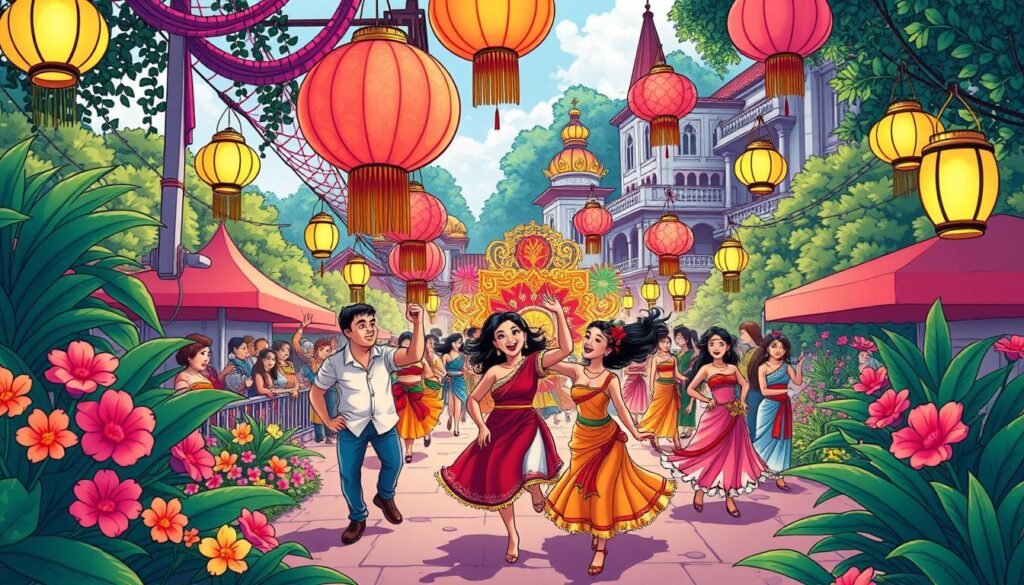
In addition to these festivals, the Philippines also hosts various events that celebrate art and culture. For example, the Fiesta Haraya Creative Caraga Festival is a showcase of the region’s creative talents. It features music, dance, and visual arts. These events demonstrate the country’s commitment to promoting innovation and artistic expression. They make the Philippines a vibrant and dynamic cultural hub.
| Festival | Description |
|---|---|
| Sinulog | Celebration of the Santo Niño, featuring a grand parade with elaborate costumes and street dancing |
| Pahiyas | Harvest festival that showcases the country’s agricultural abundance, with houses decorated with vibrant colors and creative designs |
| Fiesta Haraya Creative Caraga Festival | Showcase of the region’s creative talents, featuring music, dance, and visual arts |
The Impact of Technology on Filipino Creativity
Technology has changed how Filipinos show their creativity. Digital art and social media are now big for new ideas and designs. This lets Filipino artists share their work worldwide, reaching more people.
The digital creative field in the Philippines has grown a lot. It’s a big part of the country’s economy. According to recent statistics, the creative economy was worth $12.5 billion in 2018. This is 7.34 percent of the national GDP.
Digital Art: New Mediums for Expression
Digital art has given Filipino artists new ways to express themselves. They can do graphic design, animation, and visual effects. This lets them show their skills and innovation to people everywhere.
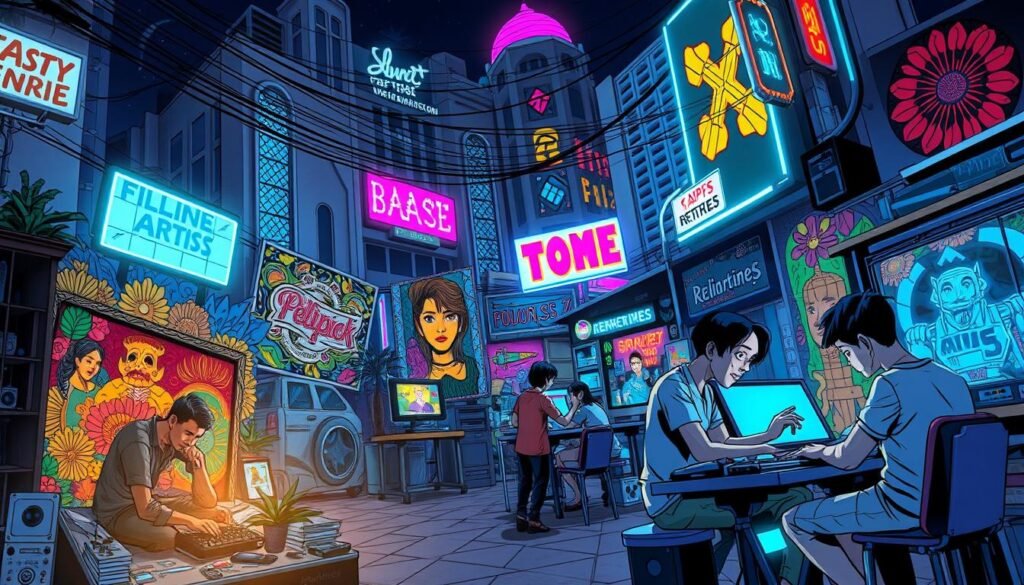
Social Media: A Platform for Emerging Artists
Social media is a place for new Filipino artists to share their work. It helps them connect with people and get noticed. This makes the art world more open, letting talent shine, no matter who you are.
- The Department of Information and Communications Technology (DICT) supports workshops and local projects to enhance digital skills among Filipinos.
- Predictive maintenance technology in manufacturing reduces unplanned breakdowns, leading to improved asset reliability and increased operational efficiency.
- The e-commerce sector in the Philippines is revolutionizing the shopping experience, allowing consumers to purchase goods from anywhere at any time.
In conclusion, technology has greatly influenced Filipino creativity. It has made innovation, design, and talent flourish in the digital world.
Filipino Creativity in Cuisine
Filipino cuisine shows the country’s culture and art in cooking. In the Philippines, sharing food is a big part of gatherings. This shows how important food is in their culture.
People in the Philippines love to try new flavors and ingredients. This shows their innovation in cooking.
A visit to Inato restaurant is a great way to see this. It mixes Filipino culture and art in its dishes. Learning to cook from family members helps families bond and pass on cooking skills.
Some famous Filipino dishes are:
- Lumpia, a popular Filipino spring roll
- Leche flan, a Filipino dessert
- Adobo, widely recognized as the National Dish of the Philippines
The phrase “sayang” in Filipino culture means no food is wasted. This shows their effort to reduce food waste and be sustainable in cooking.
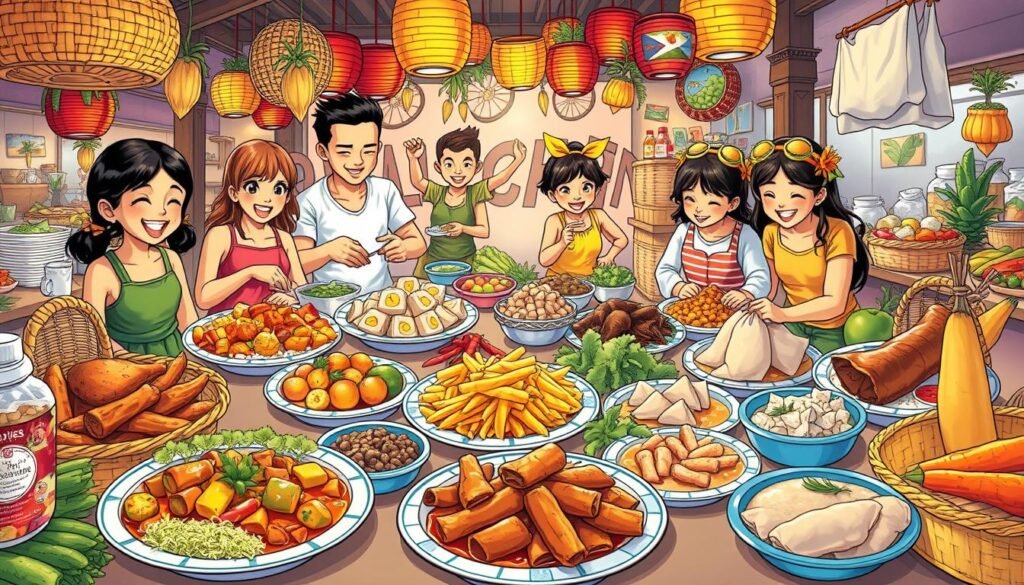
There are many different cuisines in the Philippines, showing its rich culture. For example, Northern Luzon is famous for bagnet (crispy pork belly). Central Luzon (Pampanga) is known for sisig and halo-halo.
These dishes show the art and culture of Filipino cuisine. They also show the innovation in making unique and tasty dishes.
Local Talent: Recognizing Creative Individuals
The Philippines is full of talented people who are changing the country’s culture and innovation. Artists, musicians, writers, and filmmakers are all making their mark. They are shaping the nation’s artistic scene.
Carla Leonor is one such talent. She has over a decade of experience in education. She’s the chairperson of the Interior Design Program at SoFA Design Institute. Her work aims to bring together government, private companies, and international groups to drive change.
Other groups like BRIDGE Creatives and Bughaw Creative Collective also support local talent. BRIDGE Creatives is a research institute that does industry reports and forecasts. Bughaw Creative Collective works on innovation support platforms.
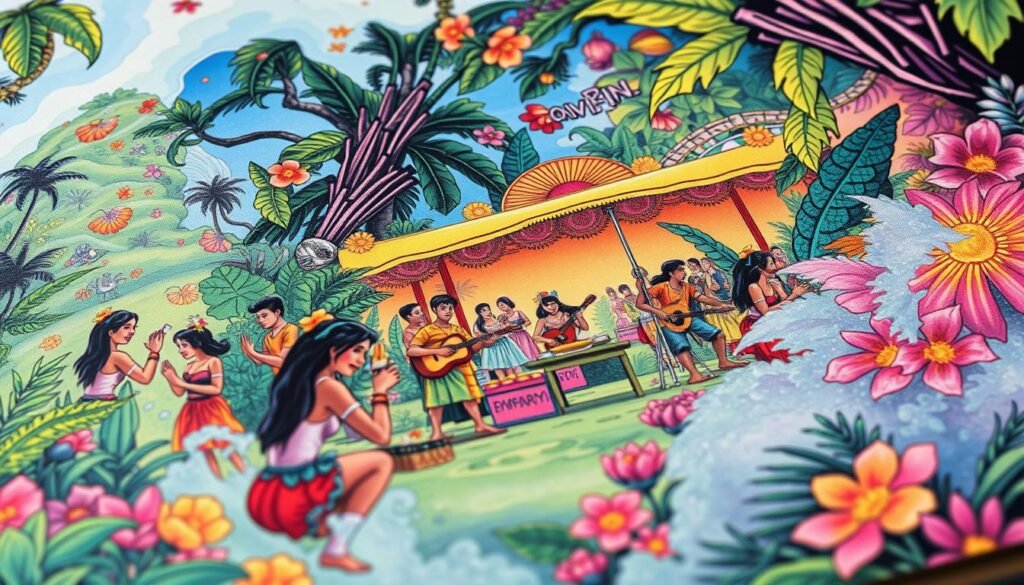
These efforts are creating a culture of innovation in the Philippines. They give local talent a chance to show off their skills. As the country grows, we can expect even more exciting contributions from its people.
| Organization | Focus |
|---|---|
| BRIDGE Creatives | Industry reports, market analytics, and future forecasts |
| Bughaw Creative Collective | Developing business support platforms centered on innovation |
Education and Creativity in the Philippines
The Philippines values education for creativity and innovation in students. A study by the OECD shows Filipino students scored 14 in creative thinking. This is much lower than the 33 points average of wealthier nations.
This gap shows the need for better education in creative thinking. It helps students adjust to a fast-changing world.
Arts education is key in schools for creative talent and design thinking. Arts and design in the curriculum give students a balanced education. This education boosts creativity and self-expression.
David Prescott Barrows, a well-known educator, says arts education is vital. It’s essential for a nation’s creative identity.
Arts Education in Schools
Arts education in schools boosts creativity and self-expression. It gives students chances to explore music, dance, and visual arts. This helps them develop their creative talent and promotes innovation.
Importance of Creativity in Learning
Creativity is key in learning. It lets students think critically and find new solutions to problems. By teaching design thinking and creative problem-solving, schools prepare students for a complex world.
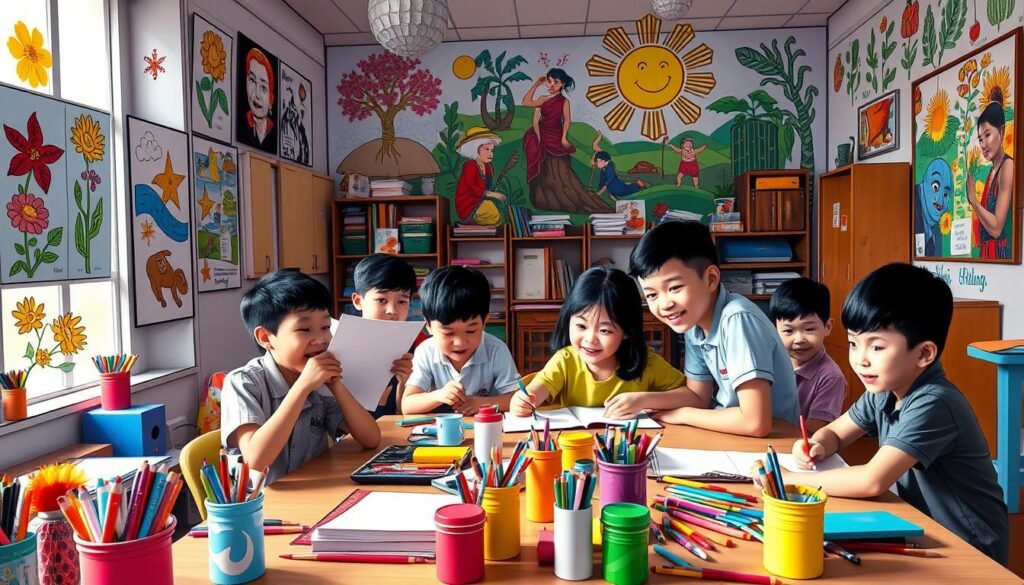
| Country | Mean Score in Creative Thinking |
|---|---|
| Philippines | 14 |
| Wealthier Nations | 33 |
Government Support for the Arts
The government is key in boosting the arts in the Philippines. It does this through various programs and initiatives. For example, the Malikhaing Pinoy program helps Filipino artists show their talents. It helps shape the country’s creative identity.
Some of the main efforts include:
- Grants and funding for artists and cultural groups
- Building arts and culture facilities
- Support for arts education and community projects
These efforts show the government’s dedication to the arts. By backing the arts, it aims to create a lively cultural scene. This can positively affect the economy and society.
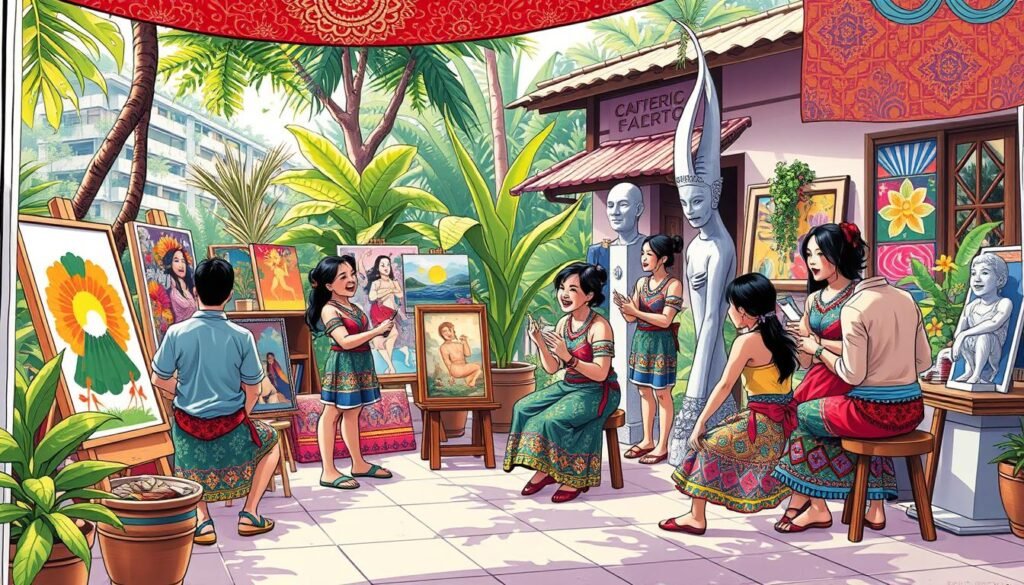
Recent data shows the arts and culture sector is worth $919.7 billion. This is 4.3% of the nation’s economy. It shows how much art, culture, and innovation contribute to the country’s growth.
| Category | Value |
|---|---|
| Arts and culture sector | $919.7 billion |
| Percentage of nation’s economy | 4.3% |
Challenges Facing Filipino Creatives
Filipino creatives face many challenges in their quest for innovation and design excellence. One big hurdle is getting access to resources and funding. This can stop them from growing their talent. A report by Prosperna shows many Filipino digital creators find it hard to make money from their work. They also struggle to protect their ideas.
Another challenge is finding the right balance between tradition and modernity. Filipino creatives must walk a thin line. They need to keep their cultural heritage alive while also exploring new ideas and technologies. This is seen in their design, which often mixes old and new styles.
The Philippines’ arts scene is a vibrant reflection of its unique culture. It’s fueled by the talent and innovation of its creatives.
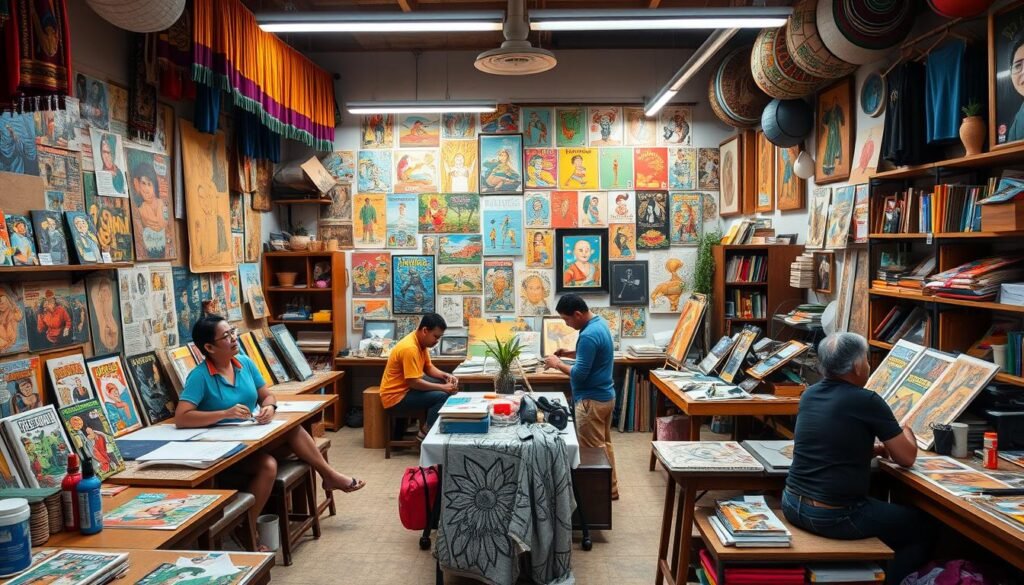
Despite these hurdles, there are many chances for Filipino creatives to shine. By supporting them, the Philippines can keep growing as a center for innovation and design in Asia.
Filipino Creativity on the Global Stage
Filipino artists are gaining international recognition, highlighting the country’s rich art and culture. The Philippine creative economy is set to reach USD 3.4 trillion by 2028. In 2022, the creative industry made up 7.3% of the country’s GDP.
Filipino innovation is making waves in film, design, and music. The Manila International Film Festival (MIFF) aims to boost Filipino talent worldwide. Efforts are underway to partner with countries like Japan to increase the Philippines’ global creative market share.
Some Filipino artists have achieved great success globally. For example:
- Generating nearly P3 trillion in revenues in 2020 through the Philippine design economy
- Contributing P1.2 trillion in gross value to the Philippine economy in 2020
- Creating over 700,000 jobs in the creative industry
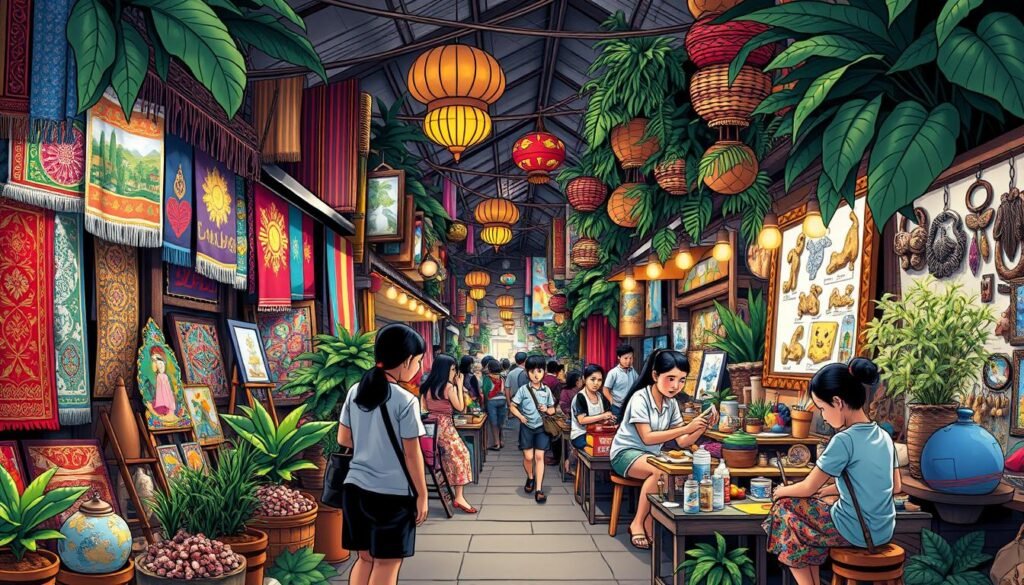
The launch of ART X DESIGN marks National Arts Month. It shows the country’s dedication to art and culture. As the creative economy expands, we can expect more Filipino artists to shine globally, blending innovation with tradition.
The Future of Filipino Creativity
The future of Filipino creativity looks bright. A new wave of artists and designers is ready to change the country’s art scene. Innovation is at the heart of this, as young creatives use new tech and ways to share their work. The Malikhaing Pinoy program shows how to grow the creative field.
Some trends that will shape the future of Filipino creativity include:
- Increased focus on design and visual arts
- Growing importance of digital media and technology
- More opportunities for talent development and recognition
As the creative industry grows, predicting the future of arts and culture in the Philippines is key. We must support innovation and design efforts. Also, we need to help young creatives grow. This way, the Philippines can become a top creative hub in the region.
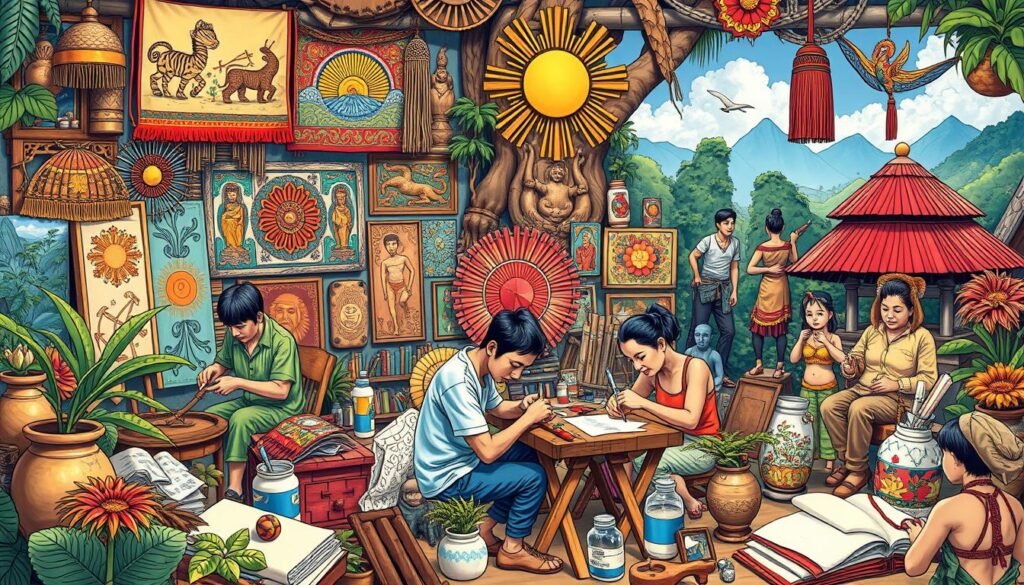
For more on the ancient Filipino script Baybayin and its role in modern design, check out this website.
Conclusion: The Ongoing Journey of Filipinos in Creativity
As we wrap up our look at Filipino creativity, it’s clear that this part of the nation’s culture is always changing. It blends old traditions with new ideas. Filipinos keep their cultural heritage alive while exploring new ways to create.
The Philippines’ many islands add to its creative spirit. Places like San Agustin Church in Manila show how art and culture are part of everyday life. These examples show how Filipino culture has stood the test of time.
Looking ahead, Filipino creativity will keep growing. New artists and innovators will shape the art world. By mixing old ways with new tech, the Philippines shows it can grow while staying true to its roots. This way, the nation’s cultural heritage will inspire new generations to create and innovate.
FAQ
What is the essence of Filipino creativity?
Filipino creativity mixes old and new, thanks to the country’s rich culture and history. It includes many art forms, like weaving and modern visual arts. Music and dance also play a big role.
How do traditional Filipino art forms contribute to the country’s creative identity?
Traditional arts like weaving and pottery are passed down through generations. They show the Philippines’ unique history and traditions. These arts make the country’s creative identity special.
How are Filipino artists interpreting and innovating their art forms?
Filipino artists are using new tech and mediums to create unique art. This includes modern visual arts, music, and dance. The country’s film industry and literature also play big roles in creativity.
How do Filipino festivals celebrate creativity and cultural heritage?
Festivals like Sinulog and Pahiyas celebrate Filipino creativity and culture. They showcase art, music, dance, and food. These festivals let artists and communities share their talents.
What is the impact of technology on Filipino creativity?
Technology has opened new ways for Filipino artists to express themselves. It includes digital art and social media. This helps them reach more people and explore new ways to create.
How are Filipino creatives making their mark on the global stage?
Filipino artists are getting recognized worldwide. They collaborate with global partners and participate in international events. This helps spread the word about Filipino creativity.
What are the challenges facing Filipino creatives, and how are they being addressed?
Filipino creatives face challenges like limited resources and funding. But, government support and education are helping. These efforts nurture new talent and support the creative community.
What is the future of Filipino creativity?
The future of Filipino creativity is promising. New trends and innovations are shaping the arts. As creatives embrace their heritage and explore new areas, the arts in the Philippines will continue to evolve and thrive.
Source Links
- SM Art Market Finale: A Nationwide Celebration of Filipino Creativity – https://www.villageconnect.com.ph/sm-art-market-finale-a-nationwide-celebration-of-filipino-creativity
- DTI’s Fiesta Haraya celebrates Philippine creative industries | Department of Trade and Industry Philippines – https://www.dti.gov.ph/archives/news-archives/dtis-fiesta-haraya-celebrates-philippine-creative-industries/
- The Importance of Recognizing Our Own Culture – https://nstp1upse.wordpress.com/2013/10/05/the-importance-of-recognizing-our-own-culture/
- Unveiling the Beauty of Traditional Pottery in the Philippines | Asterra – https://www.asterra.com.ph/articles/blog/unveiling-the-beauty-of-traditional-pottery-in-the-philippines/
- Arts in the Philippines – https://en.wikipedia.org/wiki/Arts_in_the_Philippines
- Art and Craft of the Philippines: A Tapestry of Creativity and Cultural Heritage – https://www.re-thinkingthefuture.com/articles/art-and-craft-of-the-philippines/
- Philippine Art & Philippine Paintings – https://blog.salcedoauctions.com/philippine-art-paintings/
- Contemporary Arts in the Philippines: An Introduction – https://bluprint-onemega.com/architecture/heritage/an-introduction-to-contemporary-arts-in-the-philippines/
- FLEXING FILIPINO CREATIVITY AND INNOVATION THROUGH QUALITY-MADE PRODUCTS – https://www.linkedin.com/pulse/flexing-filipino-creativity-innovation-through-products-go-lokal
- Exploring the Cultural Significance of Filipino Language and Literature – https://fluentfilipino.com/exploring-the-cultural-significance-of-filipino-language-and-literature-2/
- The Literary Forms in Philippine Literature – National Commission for Culture and the Arts – https://ncca.gov.ph/about-ncca-3/subcommissions/subcommission-on-the-arts-sca/literary-arts/the-literary-forms-in-philippine-literature/
- The Power and Potential of Creative Industries in the Philippines – https://www.gabtechglobal.com/blog/exploring-creativity-the-power-and-potential-of-creative-industries-in-the-philippines
- Background (Creative Industries) – Arangkada Philippines – https://www.investphilippines.info/seven-winners/creative-industries/background-ci/
- Fostering Filipino creativity – https://opinion.inquirer.net/107498/fostering-filipino-creativity
- Cultural festivals for the soul: 2024 events that celebrate art, design, and creativity – https://www.creativeboom.com/inspiration/festivals-that-celebrate-art-design-and-creativity/
- Festival – Festival of Creativity – https://festivalofcreativity.lk/
- Creative ways to celebrate cultural festivals through art – https://www.educationgroup.co.uk/blog/creative-ways-to-celebrate-cultural-festivals-through-art
- Empowering the Philippines through Digital Innovation – https://www.tarkie.com/empowering-the-philippines-through-digital-innovation/
- Creating & creative — the Filipino now – https://www.philstar.com/lifestyle/allure/2018/08/12/1841676/creating-creative-filipino-now
- Filipino Recipes As Legacies Of Love: What Filipino Food Culture Taught Me – https://www.shopcambio.co/blogs/news/filipino-recipes-as-legacies-of-love-what-filipino-food-culture-taught-me?srsltid=AfmBOorrokJ6sWRhjgMX0TUXSqWlNFqfhgHmSV5iiqU99N4fi56qcweE
- Filipino Creativity, Spanish Inspiration – https://allaroundbacolod.wordpress.com/2016/01/28/filipino-creativity-spanish-inspiration/
- Filipino Cuisine: A Rich Tapestry Of Culinary Traditions – https://www.eliteplusmagazine.com/Article/950/Filipino_Cuisine__A_Rich_Tapestry_Of_Culinary_Traditions
- Why is Creativity Important and What Does it Contribute? – National Youth Council of Ireland – https://www.youth.ie/articles/why-is-creativity-important-and-what-does-it-contribute/
- Creativity knows no bounds – https://tribune.net.ph/2023/06/29/creativity-knows-no-bounds
- PDF – https://ojs.cepsj.si/index.php/cepsj/article/download/1514/720/
- Learning crisis blamed for Filipino students’ poor ‘creative thinking’ – https://newsinfo.inquirer.net/1953441/learning-crisis-blamed-for-filipino-students-poor-creative-thinking
- 10 Reasons to Support the Arts in 2021 – https://www.americansforthearts.org/by-program/reports-and-data/legislation-policy/naappd/10-reasons-to-support-the-arts-in-2021
- $54 million to support vision for a Creative WA – https://www.dlgsc.wa.gov.au/department/news/news-article/2024/12/12/54-million-to-support-vision-for-a-creative-wa
- Why are Filipino teens struggling in creative thinking? Research firm urges education improvements – Manila Standard – https://manilastandard.net/news/314466752/why-are-filipino-teens-struggling-in-creative-thinking-research-firm-urges-education-improvements.html
- PH students second to last in creative thinking —PISA – https://www.gmanetwork.com/news/topstories/nation/910575/filipino-students-lag-behind-creative-thinking-in-latest-pisa-report/story/
- DTI champions Filipino creativity in the Young Creatives Challenge Grand Finals | Department of Trade and Industry Philippines – https://www.dti.gov.ph/archives/news-archives/dti-champions-filipino-creativity-young-creatives-challenge-grand-finals/
- First Lady wants to showcase PH creative industries on global stage – https://www.pna.gov.ph/articles/1237795
- President Marcos to Filipinos: Bring creativity to global stage – https://www.philstar.com/headlines/2024/02/24/2335780/president-marcos-filipinos-bring-creativity-global-stage
- Igniting the growth of the Philippines’ creative economy – Manila Standard – https://manilastandard.net/lifestyle/314506327/igniting-the-growth-of-the-philippines-creative-economy.html
- In Focus: Life as Art – The Creative, Healing Power in Philippine Culture – National Commission for Culture and the Arts – https://ncca.gov.ph/about-culture-and-arts/in-focus/life-as-art-the-creative-healing-power-in-philippine-culture/
- "Resilient Creativity: Navigating and Elevating the Philippine Creative Economy" – https://www.pochologonzales.me/2023/12/resilient-creativity-navigating-and.html
- Conclusion: The Rich Cultural Tapestry of the Philippines – https://www.re-thinkingthefuture.com/articles/conclusion-the-rich-cultural-tapestry-of-the-philippines/
- Creativity and Innovation in Philippine Business – https://www.olern.com/creativity-and-innovation-in-philippine-business/

